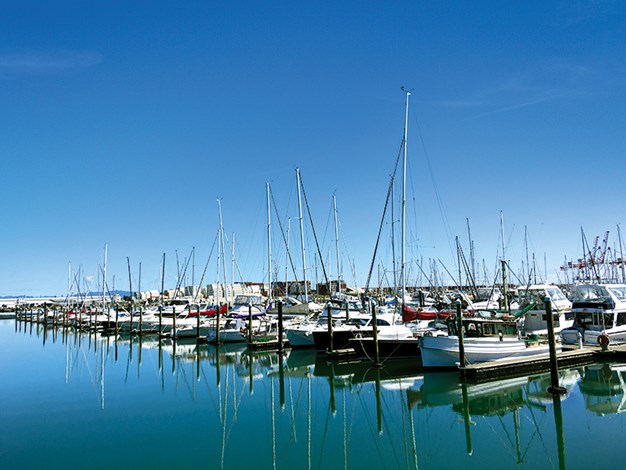 |
|
Masts, cranes and containers make a thier mark
|
It’s hard to put a finger on Tauranga. At the head of the extensive Tauranga Harbour, the city sprawls over fragmented peninsulas that on a map look like moth-eaten fabric. Entangled roads tie the city together and at first confuse visitors to the city who mostly head to ‘The Mount’, which is easier to navigate. Blessed with a knobbly mountain webbed with walking paths and an extensive beach of biscuit-coloured sand, Mount Maunganui is popular with surfers, walkers, sun worshippers and retirees from the Waikato. But on my last visit, I was determined to spread myself around and explore other parts of the metropolis. I only had three days and so I identified 10 places I thought might hold the key to a greater understanding of the city.
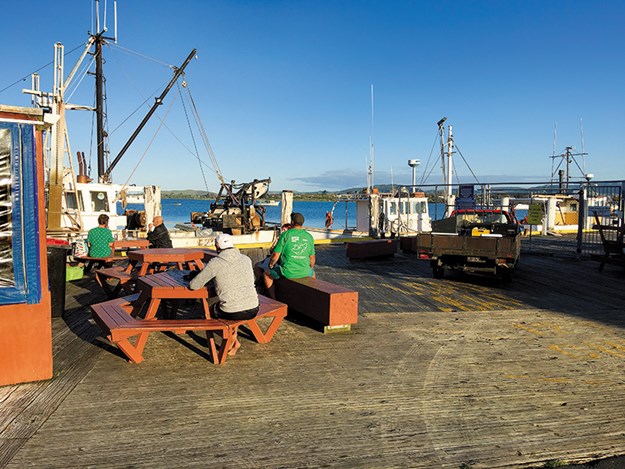 |
|
Fish and chips at Bobby’s fresh fish market
|
Something fishy
Hunger drove me to my first port of call at Bobby’s famous Fresh Fish Market on the waterfront. The outlet sells about 10 species of fresh fish as well as kina, snapper heads, kina, muttonbird and scallops but the biggest lure is the no-frills eatery where fish jump straight from fishing boat to the frying pan. Fish and chips couldn’t be more authentic unless Bobby also grows potatoes. On the wharf at a rough wooden table, Bill and I ripped into our parcels of battered snapper and chips and I’ve not tasted better. A few metres away a boat was unloading beneath a cloud of hovering seagulls.
Hairy gathering
We walked from there down The Strand that stretches along the waterfront. The evening had contracted into silence and fish boats and pleasure craft bobbed gently at anchor on a pearly pink sea. Fountains and playgrounds enliven the shore, but most interesting is the group of bronze dogs that are harassing a cat up a pole. The scene was instantly recognisable as Hairy Maclary and his gang. The author of the world acclaimed children’s books about these canines’ mischievous adventures is Lynley Dodd, who spent much of her life in Tauranga.
A postal vote
A short walk up Willow Street behind The Strand revealed a surprise. Rearing up from a steep leafy bank was an imposing building, baroque in style with walls the colour of dried blood and ornamental flourishes depicted in white. This wonderful edifice served as a post office and courthouse from 1908 until 1938. In 2001 it was purchased by Isobel and the late Michael Clarence Smythe. In 2018 their daughter Kim and her husband, restaurateur Noel Cimadom, stripped, recommissioned and decorated the building’s interior and it emerged as Clarence, a chic European-style bar, bistro and boutique hotel which is arguably one of the most eye-catching in the area. We hadn’t time to eat there but we ordered cocktails from the bar and sipped them al fresco on the terrace.
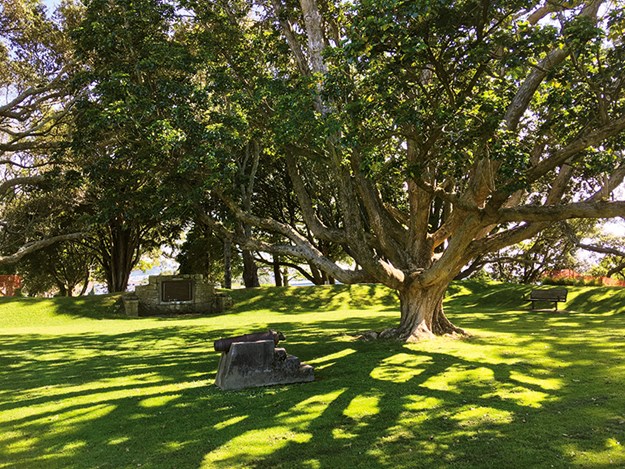 |
|
The Monmouth Redoubt
|
Talk of war
Much of the talk about Tauranga centres on how much it has grown and become modernised but, as everywhere, historic remnants help define it. I gleaned much from the Monmouth Redoubt up behind the modern police station. In 1864 during the New Zealand Wars, there were big troubles around Tauranga, and on this high knob of land overlooking the harbour, British troops erected a redoubt to repel an attack from the sea. When matters began getting out of hand British families living at the mission nearby were ordered to take cover in the redoubt, where they remained until a cutter ship arrived to take them to safety in Auckland. Today the square of the redoubt is identifiable, demarcated by high earthen banks and deep trenches that are bedecked with pohutukawa trees and a spreading oak tree shading its centre. The nearby mission house, known as The Elms, was finished in 1847 when things had settled down. Surrounded by a heritage garden, it seems a magnificent building but was currently under wraps, undergoing much needed repair. The sturdy elm I glimpsed in the garden was grown from a sucker of one of the original trees.
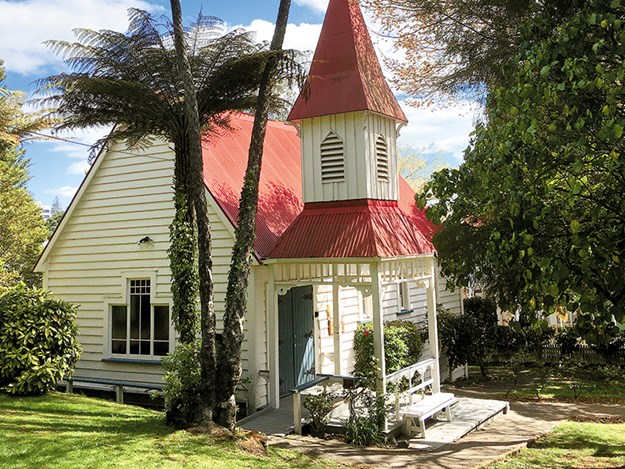 |
|
Church in the Historic Village
|
Changing places
Hoping to learn more history, I visited the Historic Village on Seventh Avenue and discovered streets made up of original and replica buildings from the 19th and early 20th centuries that have been cobbled together to simulate a village. Although I learned little history, I spent a pleasant two hours poking through the old buildings that are now in modern usage. Among them was an Art Deco cinema, a picturesque little church, a wedding dressmaker, a barber, tattoo artist, a leadlight glassmaker and The Whipped Baker cafe. Under the banner of The Incubator Creative Hub were studios, for craft makers and musicians. However, one authentic bungalow, built in 1844, added to Tauranga’s history. It was the home of John Lees Faulkner who, with his wife Ruawahine, had 13 children. John was an early boat builder, trader and postmaster. He died in 1882 and was described as a man of unshakable honesty without a single enemy. This must have been something of a feat in those war-torn times.
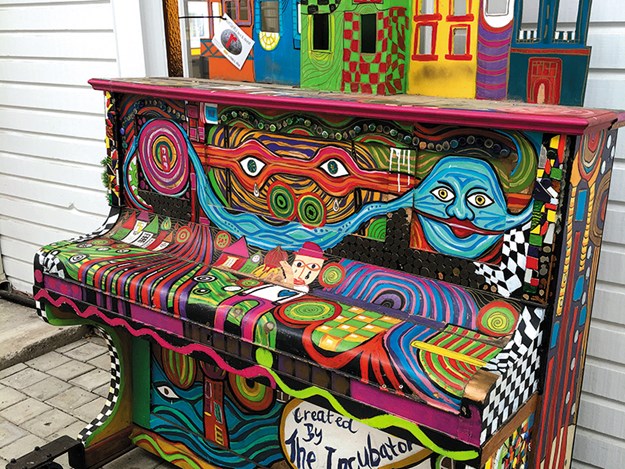 |
|
Detail at The Creative Incubator Hub
|
Fly past
The Classic Flyers Museum next to the Tauranga Airport on Jean Batten Drive is interesting, informative, and interactive and one of the city’s well-known drawcards. This history of men and their machines is tended entirely by volunteers from the Tauranga community. There are around 30 aircraft, half of them either airworthy or able to taxi. Among the ones that aren’t going anywhere I admired a Kittyhawk with shark’s teeth painted on its fuselage; a North American Harvard; the replica of a flimsy 1914 Bristol Scout C which took part in the Gallipoli Campaign; and a Fletcher top dresser (circa 1950s); If there had been time I could have gone for a genuine jaunt in a glider, a restored Boeing-Stearman bi-plane or on a scenic flight in a DC-3. Instead, I clambered through the securely grounded fuselage of a Consolidated Catalina PBY-5a. It was a mighty uncomfortable interior. Many vintage and classic craft travel to and from this base. Some for repair, others to show off.
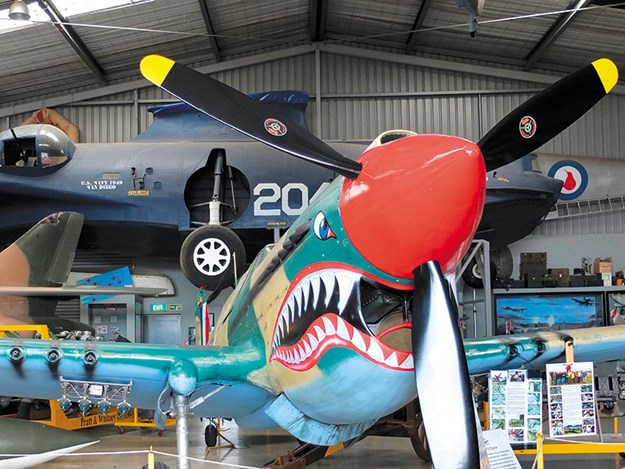 |
|
Spitfire – Classic Flyers Museum
|
Lion and Tusk
At the Flyers Museum, I read of another destination in the city’s industrial area that I couldn’t resist because of the name. The Lion and Tusk Museum seemed out of sync with anything to do with Tauranga except that it’s run by a group of men who live there and who once had connections with the Rhodesian Armed Forces during the troubled birth of Zimbabwe (no less troubled now). Through photographs, uniformed mannequins, weapons, paintings and papers and military and airforce paraphernalia, the history of the forces is maintained and worthy of a visit by anyone interested in the stupendous continent of Africa.
Bristling forests
Driving from the CBD to The Mount is a vista that distinguishes Tauranga as much as any other. A forest of spikes pierces the skyline, created by the myriad masts of leisure craft moored at the marinas and hundreds of giant cranes that crouch like praying mantises over a plethora of shipping containers stacked like children’s building blocks. I drove to Sulphur Point to immerse myself in all the rumbling, squealing and clanking of a gigantic port at work, but didn’t get far due to limited access. And I marvelled at the gargantuan tanks and silos holding unimaginable quantities of concrete, oil and grain, the warehouses storing goodness knows what, piles of timber and a mountain made of salt. Tauranga cannot be divorced from its port.
Garden of the mined
A feature that coloured my opinion of Tauranga was in a pretty orchard valley just 10km north of the city. The Te Puna Quarry, gouged for its rhyolite rock, was once nothing more than an ugly carbuncle defacing the walls of a naked cliff. Then in 1993, local volunteers began coaxing a silk purse from the sow’s ear, forming and nurturing from the damaged terrain a 32-hectare garden of infinite variety and botanical interest. Up the winding paths, I discovered ponds, groves of tree ferns, an arboretum of native trees, rhododendron dells, swathes of irises, a hillside of succulents, a butterfly garden, and New Zealand’s largest outdoor planting of Cymbidium orchids.
Shades of green
Ten minutes drive away from the central city is a place that might further enhance RVers’ opinions of Tauranga. McLaren Falls Park is 190-hectare estate set alongside the unruflled waters of a man-made lake. Roadways lead along the river and lakesides through a beautiful landscape of exotic trees that comprise one of the important botanical collections in New Zealand. The park is criss-crossed by shaded walking tracks, and central to the attractions are two waterfalls: Marshall Falls, which is the more accessible; and McLaren Falls, which is easily seen from a bridge at the park’s entrance. When water flow is cut off by the power generating station upstream, the latter’s multiple cascades are sometimes rockfalls rather than waterfalls. By way of compensation, glowworms light up the track after dark. Three delightful areas have been set aside for self-contained RVs at Top Flat, Hamilton Point and Pin Oak Flat.
Find motorhomes, caravans and RVs for sale in NZ





